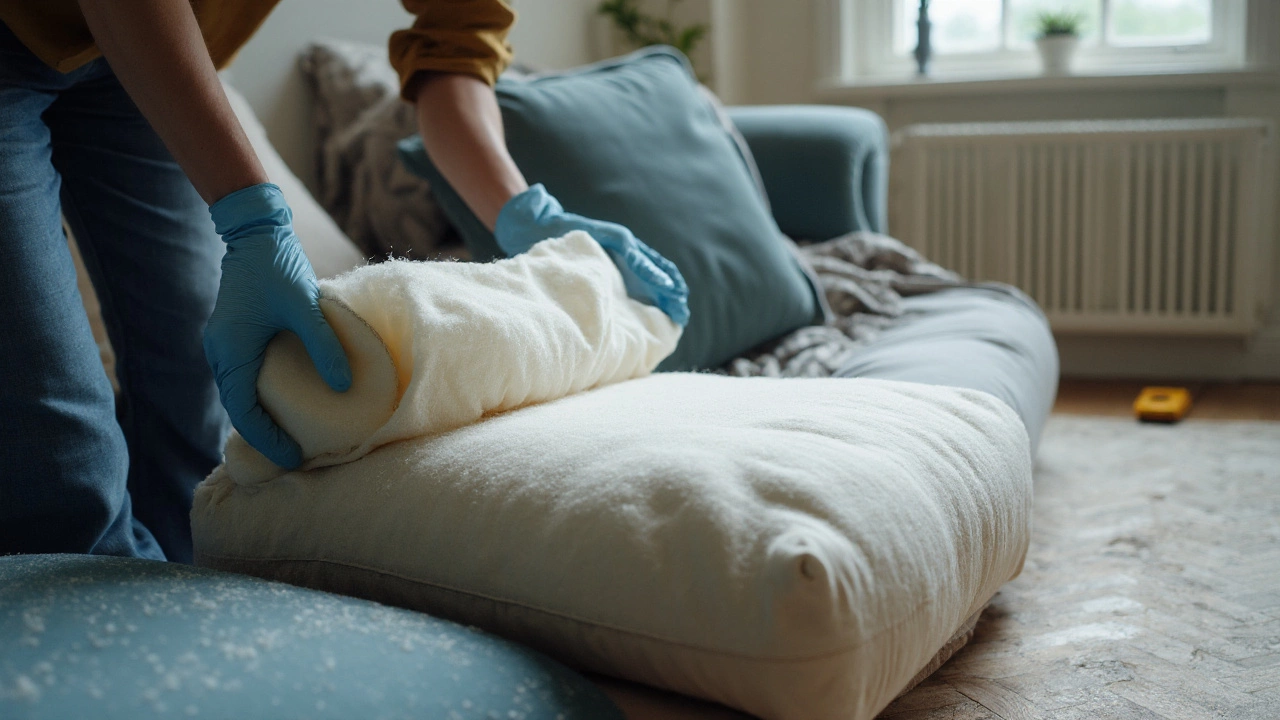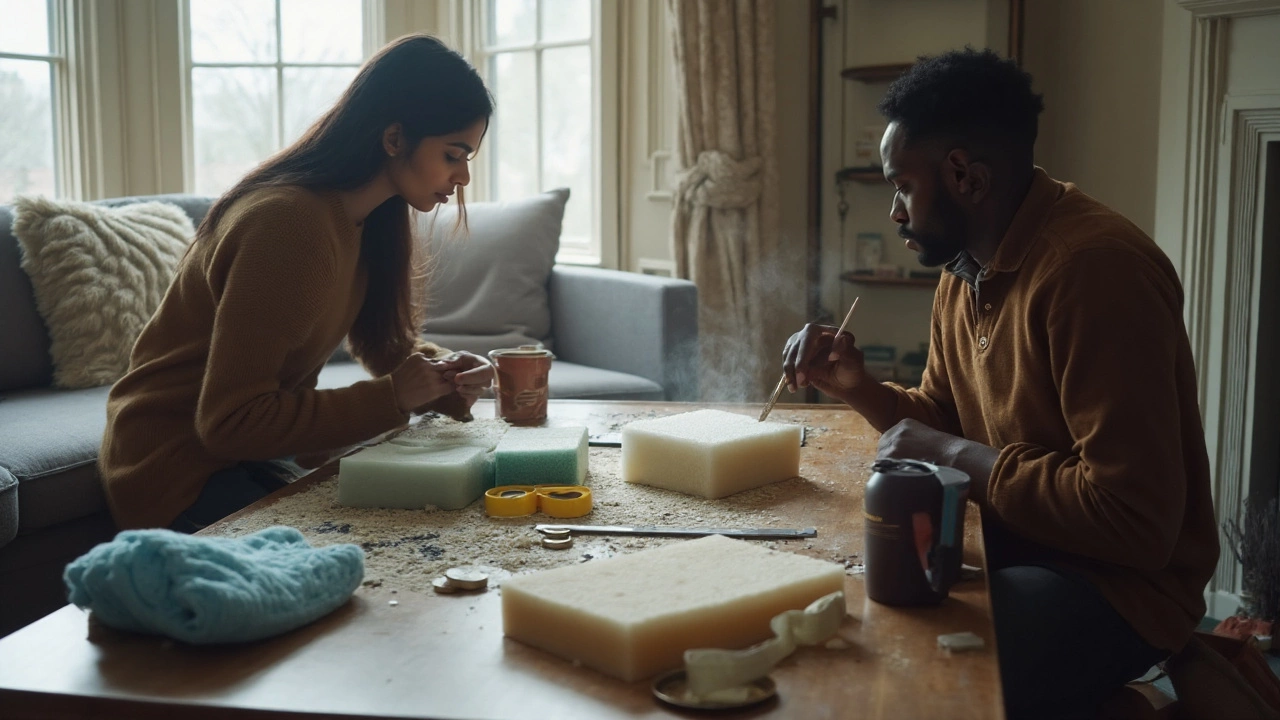If your sofa feels like a hammock or you can feel the frame under your thighs, you’re not imagining it-the foam’s given up. Most couches don’t need replacing; they need new cushion cores. In 2025 Australia, you’ll usually spend a fraction of a new sofa price, get your comfort back, and push replacement by years. The catch? It’s only worth it when the frame and suspension are still sound.
- couch cushion foam replacement is usually worth it if the frame, webbing/springs, and covers are intact.
- Typical cost in Australia: $80-$200 per seat DIY; $150-$350 per seat via upholsterer; new sofa $1,200-$3,000+.
- Expect 3-7 more years of life with good foam (35-45 kg/m³ HR) and proper wrapping.
- Don’t replace foam if the frame’s cracked, suspension is shot, fabric is torn/worn-through, or there’s odour/pest issues.
- Skill level: beginner-friendly for zip-off cushions; call a pro for sewn-in/non-removable cushions.
When replacing cushion foam is worth it (and when it isn’t)
The fastest way to decide is to check three things: support system, frame, and covers. Do these quick tests before you spend a cent.
- Support test: Lift a seat cushion and press the platform. If it’s firm, springy, and rebounds, the suspension is fine. If your hand sinks or you hear creaks, the webbing/zig-zag springs may be failing-foam won’t fix that.
- Frame test: Grab a front corner and twist gently. Feel wobble or hear cracks? You likely need repairs or a new sofa.
- Cover test: Unzip a cushion and inspect seams and zips. Tight seams and smooth zippers mean DIY is viable. Blown seams, shredded lining, or sewn-in cushions point to an upholsterer.
Green flags for replacing foam:
- Seats sag or bottom out, but the sofa is quiet and stable.
- Covers are removable and in good shape.
- Only the seat feels bad; back cushions feel fine or only need refilling.
Red flags for replacing foam:
- Broken frame or collapsed springs/webbing.
- Heavy cigarette/pet odours, mould, or pest evidence (foam change won’t fix odour embedded in fabric and frame).
- Fabric is threadbare, UV-brittle, or stained beyond cleaning (you’re heading toward full reupholstery).
How long will new foam last? With daily use, quality high-resilience foam (35-45 kg/m³) typically holds shape 4-8 years, latex 6-10 years, while cheap 20-28 kg/m³ foam can feel tired in 12-24 months. Your body weight, usage hours, cushion thickness, and whether you rotate cushions all matter.
“High-resilience foam holds its shape longer than standard foam and provides better support for seating.” - CHOICE, Sofa buying guide
If you like your sofa’s look, size, and fabric, and the bones are good, foam replacement is usually the smartest spend.
How to replace couch cushion foam (step-by-step)
You can do this in an afternoon if your cushions unzip. The hardest part is measuring properly and choosing the right density/firmness. Here’s the simple flow.
- Remove and inspect. Unzip cushions. Check the inner lining and seams. Photograph how the original foam was wrapped (batting, stockinette). Keep zippers half-closed so covers hold shape.
- Measure accurately. Lay the empty cover flat but don’t stretch it. Measure width, depth, and thickness at the middle seam-to-seam. Note any T-shapes or rounded fronts. For a snug, plump look, order foam 1-1.5 cm larger in both width and depth than the flat measurement, or follow the cutter’s fit rules.
- Choose foam. For daily-use seats in Australia, go with high-resilience (HR) polyurethane foam 35-45 kg/m³. Pick medium-firm to firm if you don’t want to bottom out. If you love a cushy top, add a 10-20 mm memory foam topper or a feather/down wrap around the HR core (but feather needs regular plumping).
- Order cut-to-size. Local foam shops (Melbourne has plenty) will cut to a template if you bring the old core or a paper pattern. Online cutters can do T-cushions and bullnoses too. Ask for edges chamfered or rounded to match the original look.
- Add a wrap. Wrap the foam with 200-300 gsm polyester wadding (Dacron) and secure with spray adhesive or light tape. If your covers are tight, add stockinette (or lightweight knit) over the wrap so the foam slides in easily and zippers don’t snag.
- Insert and seat. Fold the front corners in slightly, insert the foam, and work it into the corners with flat palms. Zip while compressing the foam to reduce stress on the zip. Sit on it to settle. Rotate front-to-back if reversible.
- Break-in and adjust. Foam softens a touch in the first 2-4 weeks. If it’s too firm, a thin topper under the wrap can fix it. If it’s loose, add a second layer of wadding.
Tools and supplies:
- Tailor’s tape and a rigid ruler
- Marker and paper for templates (for T-cushions)
- HR foam cut-to-size; optional 10-20 mm memory foam topper
- Polyester wadding (Dacron) 200-300 gsm; stockinette/cover sock
- Spray adhesive rated for foam (low-VOC is nicer indoors)
- Long zip slider pull (paperclip works) and a helper for tight covers
Safety tips:
- Let spray adhesive flash off outdoors before bringing cushions inside.
- If cutting foam at home, an electric carving knife or a fine-tooth handsaw works-cut slowly with light pressure.
- Avoid compressing zippers with pliers; that shortens their life.

Costs, foam types, and picking the right firmness
Here’s what Aussies are paying in 2025 and how different foams compare. Prices vary by city and cushion size; these ranges reflect typical 60 × 60 × 10-13 cm seat cushions.
| Option / Foam | Density / Spec | Feel & Use | Typical Cost per Seat (AUD) | Expected Lifespan | Best For |
|---|---|---|---|---|---|
| Standard PU foam | 20-28 kg/m³ | Soft, compresses quickly | $30-$70 | 1-2 years | Light use, staging |
| HR (High-Resilience) PU foam | 35-45 kg/m³ | Supportive, springy, everyday use | $80-$150 | 4-8 years | Main seating, families |
| Latex (blended) | ~65-85 kg/m³ equiv. | Responsive, breathable, heavy cushions | $140-$220 | 6-10 years | Hot climates, natural feel |
| Memory foam topper | 10-20 mm over HR core | Soft top, pressure relief | + $20-$40 | Follows core | Softer sit without sinking |
| Feather/down wrap | Wrap around HR core | Plush, luxe, needs fluffing | + $40-$120 | 3-6 years | Cloud feel lovers |
| Professional refit (installed) | HR foam + wrap | Perfect fit, no fuss | $150-$350 | 4-8 years | Non-DIY, complex shapes |
DIY vs. new sofa rule of thumb: if your sofa is structurally sound and you like it, spending 10-25% of a new sofa’s price on new cores is nearly always worth it. You’ll restore support, keep fabric you already like, and dodge delivery delays.
Choosing firmness without the guesswork:
- Seat density: aim for 35-45 kg/m³ HR foam for daily use. Under 30 kg/m³ will go flat faster.
- Firmness (ILD): suppliers use different scales. If they show ILD (pounds) pick medium-firm 35-45 for most adults. If they show “soft/medium/firm,” choose firm for seats thinner than 10 cm, medium-firm for 10-13 cm, or medium if you’re very light.
- Thickness matters: thin cushions need firmer foam to avoid bottoming out. Thick cushions can be a touch softer.
- Mix it if needed: some households do firmer foam on main seats, softer on chaise/occasional spots.
Certification and air quality: To reduce VOCs and flame retardant nasties, look for CertiPUR-US certified foams or local suppliers referencing GECA criteria. In Australia, upholstery foams don’t carry the same flammability regs as the UK, but common-sense fire safety (keep away from heaters, no smouldering cigarettes) still applies. If you’re sensitive to smells, air cushions out for 24-48 hours before use.
What about back cushions? Most back cushions use hollow fibre (polyfill) or a feather/microfibre blend. If they’re slouchy but the fabric is fine, you can top them up with new fill bags or replace the inner. HR foam in backs can feel too stiff; a hybrid (thin foam sheet wrapped in fibre) keeps shape without feeling rigid.
Real-world example (Melbourne): Three-seat sofa with 3 removable seat cushions at 62 × 62 × 12 cm. Supplier quotes HR 38 kg/m³ foam cut-to-size at $110 per cushion; wadding and stockinette $20 each; total DIY materials $390. Two hours of work at home. The same job via an upholsterer quoted $690 (incl. pick-up/drop-off). A comparable new sofa is $1,799-$2,499. The foam refit gives another ~5 years of comfy seating for about 15-38% of replacement cost.
FAQ, quick checklists, and your next steps
Here’s the stuff people usually ask once they start measuring.
Quick decision checklist
- Frame solid and quiet? Yes → proceed. No → get a repair quote first.
- Support platform springy? Yes → foam will help. No → fix webbing/springs.
- Covers removable and intact? Yes → DIY friendly. No → ask an upholsterer.
- Budget $80-$150 per seat for HR foam? Yes → green light.
- Happy with current fabric/style? Yes → foam swap makes sense.
Measuring cheat sheet
- Measure the empty cover seam-to-seam at the centre-not the old foam (it’s distorted).
- Order 10-15 mm oversize on width/depth for a plump, non-baggy fit.
- Match thickness to the original; if you go thicker, zips may hate you.
- Curves/T-cushions: make a paper template and label front/back.
Care and longevity tips
- Rotate cushions monthly (front-to-back and across positions if possible).
- Vacuum seams to reduce grit that abrades foam and fabric.
- Keep out of direct sun; UV cooks fabric and dries foam faster.
- Avoid sitting on the same spot all the time; share the load.
Mini-FAQ
Is latex better than HR foam? Latex keeps its shape longer and breathes better but is heavier and pricier. If you want the bounciest feel and longest life, latex is great. If budget matters, HR foam hits the sweet spot.
My cushion is attached (no zip). Can I still replace the foam? Yes, but it’s a pro job. An upholsterer can open the seam, refit foam, and close neatly. Expect $200-$400 per seat depending on complexity.
What firmness should I choose for a 90-100 kg adult? Medium-firm to firm HR foam (around 38-45 kg/m³) in 10-13 cm thickness feels supportive without being board-hard.
Can I stack two layers of cheap foam? You can, but it will feel spongy and fail early. One quality core lasts longer and supports better.
Do I need a feather wrap? Only if you want that sink-in luxury. A thin memory foam topper under wadding gives a soft top with less maintenance than feathers.
Will new foam fix my sofa’s squeak? No. Squeaks are frame or spring noise. Sort that first.
What about sustainability? Replacing foam keeps a whole sofa out of landfill. Ask suppliers about recycled-content foam or take old foam to council hard rubbish; some recyclers accept clean foam offcuts-policies vary by council, so check local guidelines.
Troubleshooting
- Foam won’t fit in the cover: Don’t force it with the zip. Use a stockinette sock, compress by hand, and insert the front edge first. Still huge? Peel off one layer of wadding or have the edges chamfered by the supplier.
- Seat still feels hard: Sit on it for two weeks-it softens slightly. If it’s still brick-like, add a 10 mm soft topper under the wrap rather than swapping the whole core.
- Seat bottoms out: Either the foam is too soft or the platform is failing. Try firmer foam first; if that doesn’t help, repair/replace webbing or springs.
- Cover looks baggy: Add an extra layer of wadding, especially at edges and front roll. Or order foam 10-15 mm wider/deeper next time.
- Strong smell from new foam: Air cushions out in a ventilated room 24-48 hours. Look for low-VOC foams next time (CertiPUR-US/GECA referenced).
Your next steps
- Unzip one cushion and measure the cover today.
- Call a local foam cutter in Melbourne (or your city) and ask for HR 38-45 kg/m³ cut-to-size with a light wadding wrap.
- Order one cushion first as a fit test before doing the set.
- Fit it, sit on it for a week, then order the rest.
Bottom line: If your sofa’s structure is healthy, replacing the cushion cores is one of the best-value home fixes you can make-fast, relatively cheap, and very satisfying every time you sit down.


